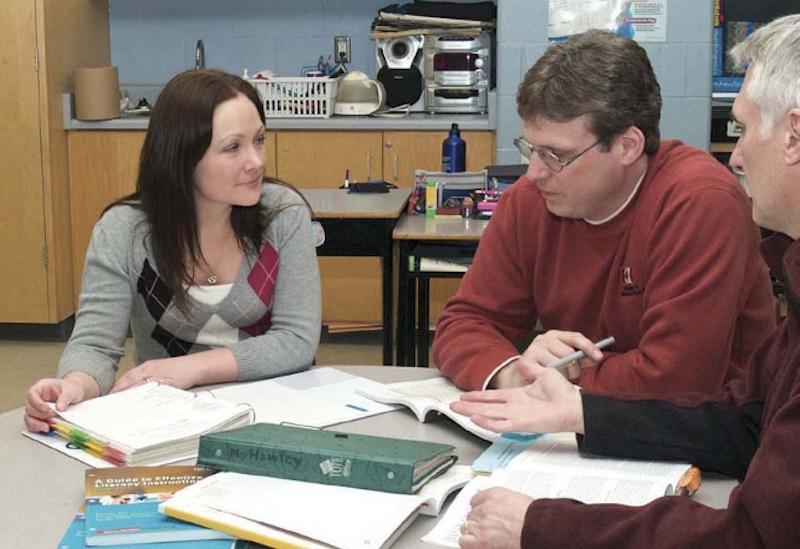
Developing a Professional Learning Community from Scratch
During the summer of 2006, as I was working through an AQ course, there was one question that I endlessly fretted over: how to initiate a professional learning community (PLC).
In the end, my solution was simple: I contacted all of my Junior division colleagues and suggested we should endeavour to work together. The invitation was open, but I was determined that the numbers would not matter, and that we would move forward with a group of two, three, or seven. One teacher, who was more isolated than the rest of us because she worked at two different schools, showed up for our first meeting. I was surprised, but happy to see her. The first words out of her mouth were “Why are we here?”.
There were a number of issues that persuaded us to work together. One was that we worked mostly in isolation. Second, as was soon apparent, we were worried about top-down management, and felt that if we worked together as a team – strength in numbers – it would be hard for a principal to say no. Third, I had found that having students more than one year (called looping) was beneficial in many ways. Teaching the same students a second year means you know most of them and can begin where you left off the previous June. Routines also are simply continued from the previous year. Through observation and discussions with parents, I’ve found that even our best students may need at least two years to get on track toward independence.
But when we do not usually have our students for more than one year, how do we achieve the same results? How do we ensure consistency with note-taking, notebook organization, or assessment? And how do we reach the high expectations we set for our students? The answer is obvious: through collaboration teachers can maintain standards and procedures from one year to the next. For example, before the end of September, we had presented a list of at-risk students from the Junior division. American author and educator Richard DuFour mentions the “powerful collaboration of school teams.” By working together, we found we could focus more specifically on student achievement.
Creating a divisional PLC
We started our PLC by examining the needs of our Junior division students. Although mindful of the importance of a school focus, I would suggest divisional teams as a more powerful beginning for a PLC; this arrangement can address common student needs, has an immediate “looping” effect, and involves smaller numbers of staff. Through board and ministry assessment, and through teacher observation and collaboration, we identified a need to improve our students’ writing.
We decided together how to improve our students' writing skills. Grade 6 teachers took the lead by discussing what they wanted students to learn in prior grades. (Later in the process, grade 3 teachers should be invited into the PLC to hear Junior teachers’ expectations.) We decided to focus on different forms of writing, and to emphasize narrative writing. Each grade would focus on a particular genre; for example, the grade 4s focused on fairy tales, the grade 5s on mysteries, and the grade 6s on adventures. Each teacher had a voice and felt comfortable contributing to the free flow of ideas. In our PLC no single teacher was in charge and we learned from each other.
Finding time to plan together
With our time constraints we had to be mindful of how we planned. Time is an issue for any PLC. My suggestion is to work together to develop ideas and time for planning. For example, we were able to free up teachers to plan when we had all the Junior students in the gym at the same time to write the board’s reading assessment. Teachers were not only given more time to plan, but they were able to work one on one with students who needed extra support and didn’t often receive it.
We began by reviewing ministry writing exemplars with students. Like-grade classes worked together and held peer and teacher writing conferences once a week. Student writing must be considered formative assessment. Students kept all copies of their work. Continuous descriptive feedback was provided orally and in writing. The added benefit for students was that they had the opportunity to improve not only their writing but their marks as well, in an atmosphere where risk-taking was encouraged. Weeks later we were still working with students on this piece of writing. Teachers wondered if we should give up, but we had to look at where we had started, and consider that we had put in place a long-term plan. In other words, next year’s teachers would build on the instruction students had received the previous year.
Reaping the benefits
A wonderful part of our PLC was that everyone in our division was on the same page as we assigned similar work, and discussed what worked well and what didn’t. (This is one of the characteristics of a properly functioning PLC, according to eworkshop.ca.) We shared ideas for poetry forms and common themes, for example, and displayed student work in our hallways.
An added benefit, as we worked together, was the reduced stress that resulted from a collegial atmosphere and better organization and ideas. For example, board assessment (which involves hours of preparation and marking, but the results of which we cannot use as a report card mark) was less of a burden. One of the strengths of the PLC is that it is a flexible, long-term plan that can be improved on from one year to the next. However, teachers realized students do not improve overnight. This is the antithesis of what Diane Sweeney calls “one-shot in-services,” which accomplish very little. By exchanging ideas, we were adding to each other’s professional development, but we were planning for long-term change.
Keeping the principal in the loop
All of this planning was done on our own initially. We met at my place and on a casual basis at our school. Communication was a concern, as the message was often lost as it went from teachers through our chairperson to the principal and back, leading us to realize that the principal must be invited into the group at some point. As well, we had informed our principal of our intentions during the summer while developing our PLC. This was important: the timetable was developed so that all the Junior teachers (and all our students) were free at the same time for one period a week, allowing us to work together.
An interesting aspect of the collegiality evident in our PLC was that teachers began to share the workload. We planned division-wide excursions to a movie and to a Blue Jays game, but no longer was one teacher organizing most of the extracurricular activities. We also invited a cartoonist in to work with all our classes. As students developed their cartooning skills they were asked to illustrate their written work.
The wave of the future
Teacher-initiated PLCs should be the wave of the future. We must start by taking responsibility for our own professional learning. When we look at the business world, we see that creative thinking and working with others are skills that are often emphasized. As teachers we can be creative and collaborative. We can learn from each other. Look at yourself and your colleagues. What skills and expertise do you each have that would benefit other teachers and your students? Sharing our skills formed the core of our Junior division professional learning community. Both new and experienced teachers benefited from this approach. To quote eworkshop.ca: “Teacher efficacy – the ability to produce an intended/desired result – is increased through opportunities for teacher learning and collaboration and, in turn, student learning improves.”
Our ministry and our boards must encourage school administrators, who, in turn, must encourage and support teacher-initiated professional development in order to improve the focus on student achievement. If, on the other hand, we allow PLCs to be developed for us – if the approach is only top-down – then, by our own doing, PLCs will become another useless and wasted professional development opportunity.
Sources
Barber, M., and M. Fullan. “‘tri-Level development’: putting Systems thinking into action.” Education Week, March 2, 2005.
Conzemius, Anne, and Jan o’neill. The Handbook for SMART School Teams . Bloomington, in: national educational Service, 2002.
DuFour, richard. “What is a professional Learning Community?” Educational Leadership, 61 (8), 6-11.
Sweeney, Diane. Learning Along the Way: Professional Development by and for Teachers.
Portland, Me: Stenhouse publishers, 2003.

